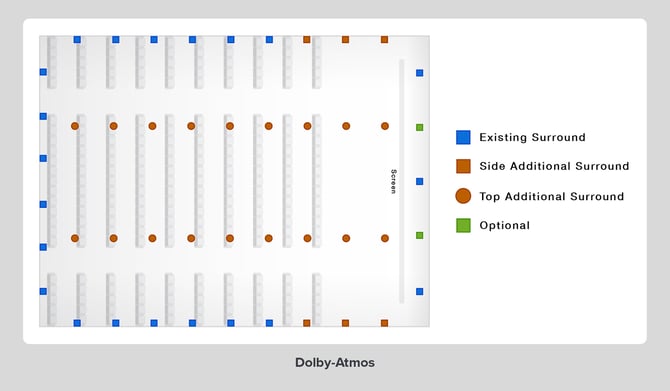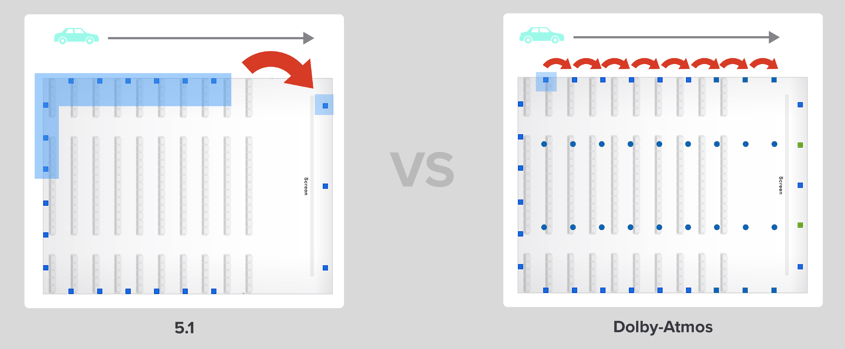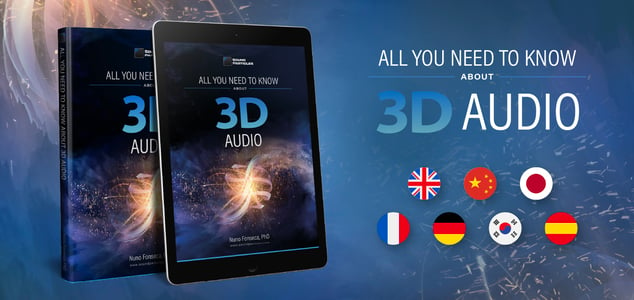Now that you know everything about channel-based audio, it's time to get to the next topic: object-based audio, which includes formats like Dolby Atmos, which you probably already heard about.

In this type of audio, instead of mixing sounds to the output channels that we want, like in channel-based audio, we keep each channel completely independent, add some data about their position (metadata) - like the 3D position, the size or movement - and finally, we are going to distribute these independent channels (objects). Then, during reproduction, based on these settings, the render will decide what to play in each speaker - everything in real-time.
But let's get into it!
What is Object-based audio?
Object-based audio started to get some attention with the release of Dolby Atmos. Instead of mixing all sounds in the studio and distributing the final mix, object-based audio uses a different approach by distributing all sounds independently, which are mixed only during reproduction.
In the studio, you will still use a panner to position your sound, but you don’t apply that panning information to the sound – you simply say where you want your sounds to be positioned. That information is distributed, and during reproduction, depending on your actual reproduction system, that panning information is actually applied to sound.

One of the most well-known systems using object-based audio is Dolby Atmos, and we will talk about it right now, but there are other object-based audio formats, such as MPEG-H, AuroMax, DTS:X.
Dolby Atmos supports both object-based audio (objects) and channel-based audio (beds). An object will have its audio (mono audio clip) and the corresponding metadata, but Dolby Atmos also supports channel-based audio, by using 7.1.2 beds (7.1 + 2 height channels). Let’s focus on objects.
Dolby Atmos supports 128 independent channels, which means that we may have up to 118 audio objects plus 10 channels reserved for a 7.1.2 bed (more info on beds later on). During reproduction, Dolby Atmos supports up to 64 independent speakers, which means that a movie theater may have up to 64 speakers which are controlled independently, meaning that each speaker can reproduce audio that is different from all other speakers. The room may even have more than 64 speakers, as long as some of them share the same audio signal.
A movie theater with Dolby Atmos support will be slightly different from a regular 5.1/7.1 room.

During the production of a movie, some audio content may have been already pre-mixed. For instance, the music score could be delivered to the re-recording mixers already mixed, or at least pre-mixed in stems (7.1 strings, 7.1 brass, etc.); or imagine a sound effect ambiance that was already recorded or edited in 5.1.
Besides objects, Dolby Atmos also supports channel-based content which is called audio beds. This means we can also include “regular” channel-based audio. Dolby Atmos uses 7.1.2 beds, which correspond to a traditional 7.1 (3 front + 4 surround channels + LFE) with 2 additional channels for the ceiling (one on the left side of the ceiling, and another on the right side of the ceiling). For instance, all existing 5.1 and 7.1 tracks can be directly mixed to a 7.1.2 bed. And even without using objects, a mixer can still explore the height component, by sending audio to the overhead speakers.
With objects, each sound must be independent, as a way to control its panning, but with the beds that is not an issue since we use “regular” panning to place the sounds around. As such, the re-recording mixer could use objects for the most important or relevant sounds, where accurate localization is more critical, and mixed secondary sounds in beds.

And so we finish today's topic, our video series about the basics of 3D audio continues and we suggest you to watch the following video about object-based audio to get a more insightful explanation about it and also a couple of curiosities about immersive audio that you probably didn't know 😉
Did you know our free eBook "All You Need to Know About 3D Audio" is now translated into 4 new languages?

After the success of the English, Chinese and Japanese versions, Sound Particles brings four more translations, French, German, Korean and Spanish, with the goal of helping professionals around the world to transition into the immersive audio field. With this free eBook, sound enthusiasts will be able to find all the answers they’re looking for in a detailed, complete and easy-to-read guide.
If you want to be the first to get all the fresh news, subscribe to our Newsletter!
.png?width=839&name=blog-newsletter-banner%20(2).png)
Topics: Sound Particles, Audio Software, Sound Design, Film, Sound for Film and TV, Audio tech, 3D audio, Surround Sound, Gaming Audio, Webinars
